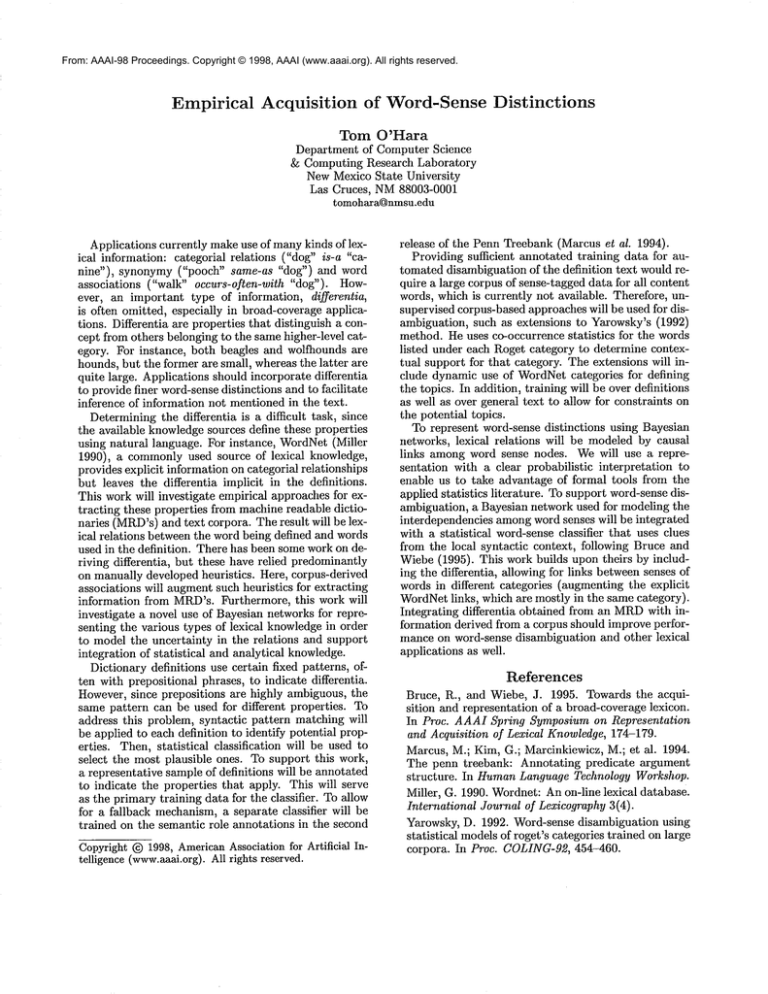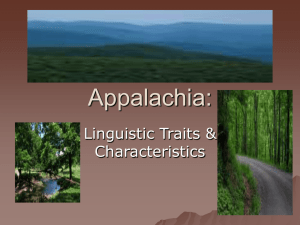
From: AAAI-98 Proceedings. Copyright © 1998, AAAI (www.aaai.org). All rights reserved.
Empirical
Acquisition
of Word-Sense
Distinctions
Tom O’Hara
Department of Computer Science
& Computing Research Laboratory
NewMexico State University
Las Cruces, NM88003-0001
tomohaxa@nmsu.edu
Applications currently makeuse of manykinds of lexical information: categorial relations ("dog" is-a "canine"), synonymy ("pooch" same-as "dog") and word
associations ("walk" occurs-often-with "dog"). However, an important type of information, differentia,
is often omitted, especially in broad-coverageapplications. Differentia are properties that distinguish a concept from others belonging to the same higher-level category. For instance, both beagles and wolfhounds are
hounds, but the former are small, whereasthe latter are
quite large. Applications should incorporate differentia
to provide finer word-sensedistinctions and to facilitate
inference of information not mentionedin the text.
Determiningthe differentia is a difficult task, since
the available knowledgesources define these properties
using natural language. For instance, WordNet(Miller
1990), a commonlyused source of lexical knowledge,
provides explicit information on categorial relationships
but leaves the differentia implicit in the definitions.
This work will investigate empirical approaches for extracting these properties from machinereadable dictionaries (MRD’s)and text corpora. The result will be lexical relations betweenthe word being defined and words
used in the definition. There has been somework on deriving differentia, but these have relied predominantly
on manually developed heuristics. Here, corpus-derived
associations will augmentsuch heuristics for extracting
information from MRD’s.Furthermore, this work will
investigate a novel use of Bayesian networks for representing the various types of lexical knowledgein order
to model the uncertainty in the relations and support
integration of statistical and analytical knowledge.
Dictionary definitions use certain fixed patterns, often with prepositional phrases, to indicate differentia.
However,since prepositions are highly ambiguous, the
same pattern can be used for different properties. To
address this problem, syntactic pattern matching will
be applied to each definition to identify potential properties. Then, statistical classification will be used to
select the most plausible ones. To support this work,
a representative sample of definitions will be annotated
to indicate the properties that apply. This will serve
as the primary training data for the classifier. To allow
for a fallback mechanism,a separate classifier will be
trained on the semantic role annotations in the second
Copyright(~) 1998, AmericanAssociationfor Artificial Intelligence (www.aaai.org).All rights reserved.
release of the Penn Treebank(Marcus et al. 1994).
Providing sufficient annotated training data for automated disambiguation of the definition text wouldrequire a large corpus of sense-tagged data for all content
words, which is currently not available. Therefore, unsupervised corpus-based approacheswill be used for disambiguation, such as extensions to Yarowsky’s(1992)
method. He uses co-occurrence statistics for the words
listed under each Roget category to determine contextual support for that category. The extensions will include dynamic use of WordNetcategories for defining
the topics. In addition, training will be over definitions
as well as over general text to allow for constraints on
the potential topics.
To represent word-sense distinctions using Bayesian
networks, lexical relations will be modeledby causal
links among word sense nodes. Wewill use a representation with a clear probabilistic interpretation to
enable us to take advantage of formal tools from the
applied statistics literature. To support word-sensedisambiguation, a Bayesian network used for modeling the
interdependencies amongword senses will be integrated
with a statistical word-senseclassifier that uses clues
from the local syntactic context, following Bruce and
Wiebe (1995). This work builds upon theirs by including the differentia, allowing for links betweensenses of
words in different categories (augmenting the explicit
WordNetlinks, which are mostly in the same category).
Integrating differentia obtained from an MRD
with information derived from a corpus should improve performance on word-sense disambiguation and other lexical
applications as well.
References
Bruce, 1~., and Wiebe, J. 1995. Towards the acquisition and representation of a broad-coveragelexicon.
In Proc. AAAI Spring Symposium on Representation
and Acquisition of Lexical Knowledge,174-179.
Marcus, M.; Kim, G.; Marcinkiewicz, M.; et al. 1994.
The penn treebank: Annotating predicate argument
structure. In HumanLanguage Technology Workshop.
Miller, G. 1990. Wordnet:An on-line lexical database.
International Journal of Lexicography3(4).
Yarowsky, D. 1992. Word-sense disambiguation using
statistical modelsof roget’s categories trained on large
corpora. In Proc. COLING-92,454-460.









